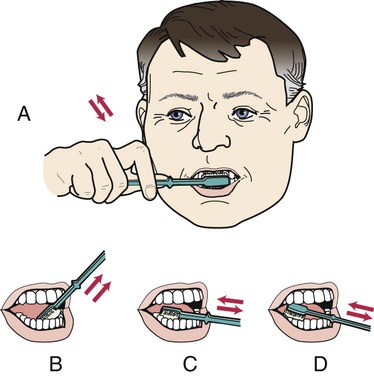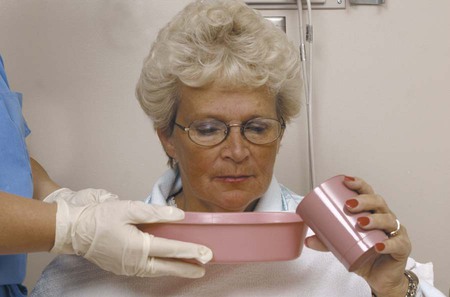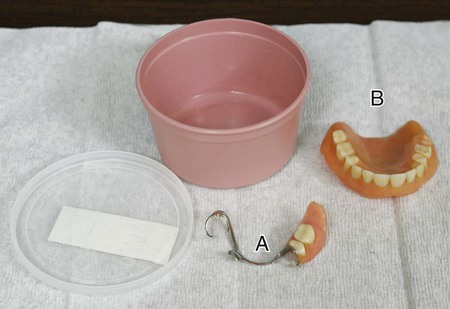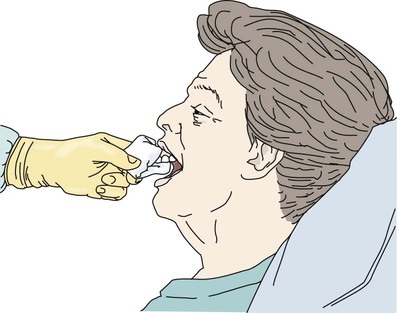• Define the key terms and key abbreviations listed in this chapter. • Explain why personal hygiene is important. • Identify the observations to report and record when assisting with hygiene. • Describe the care given before and after breakfast, after lunch, and in the evening. • Explain the purposes of oral hygiene. • Describe safety measures when giving mouth care to unconscious persons. • Explain how to care for dentures. • Describe the rules for bathing. • Identify safety measures for tub baths and showers. • Explain the purposes of perineal care. • Perform the procedures described in this chapter. • Explain how to promote PRIDE in the person, the family, and yourself. See Focus on Communication: Assisting With Hygiene, p. 228. See Focus on Older Persons: Assisting With Hygiene, p. 228. See Promoting Safety and Comfort: Assisting With Hygiene, p. 228. • Keeps the mouth and teeth clean. • Prevents mouth odors and infections. • Reduces the risk for cavities (dental caries) and periodontal disease (gum disease, pyorrhea). The nurse assesses the person’s need for mouth care. Illness, disease, and some drugs often cause: • A whitish coating in the mouth and on the tongue. • Redness and swelling in the mouth and on the tongue. • Dry mouth. Dry mouth also is common from oxygen, smoking, decreased fluid intake, and anxiety. See Delegation Guidelines: Oral Hygiene. See Promoting Safety and Comfort: Oral Hygiene. • Position the person on 1 side with the head turned well to the side (Fig. 16-4). In this position, excess fluid runs out of the mouth. • Use only a small amount of fluid to clean the mouth. • Do not insert dentures. Dentures are not worn when the person is unconscious. Keep the person’s mouth open with a padded tongue blade (Fig. 16-5). Do not use your fingers. The person can bite down on them. The bite breaks the skin and creates a portal of entry for microbes. Infection is a risk. Mouth care is given at least every 2 hours. Follow the nurse’s directions and the care plan. See Focus on Communication: Mouth Care for the Unconscious Person, p. 232. See Promoting Safety and Comfort: Mouth Care for the Unconscious Person, p. 232. See procedure: Providing Mouth Care for the Unconscious Person, p. 232. A denture is an artificial tooth or a set of artificial teeth (Fig. 16-6). Often called “false teeth,” dentures replace missing teeth. Mouth care is given and dentures cleaned as often as natural teeth. Dentures are slippery when wet. They easily break or chip if dropped onto a hard surface (floors, sinks, counters). Hold them firmly when removing or inserting them. During cleaning, firmly hold them over a basin of water lined with a towel. This prevents them from falling onto a hard surface. See Promoting Safety and Comfort: Denture Care. See procedure: Providing Denture Care.
Assisting With Hygiene
Oral Hygiene
![]() Mouth Care for the Unconscious Person
Mouth Care for the Unconscious Person
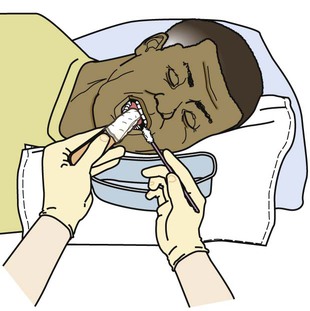
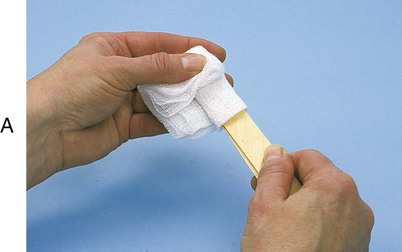
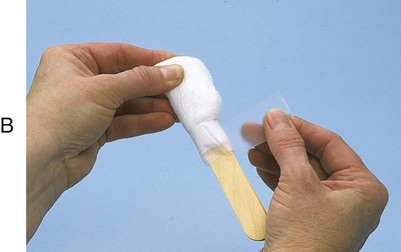
A, Place 2 wooden tongue blades together. Wrap gauze around the top half. B, Tape the gauze in place.
![]() Denture Care
Denture Care
Assisting With Hygiene
Get Clinical Tree app for offline access

